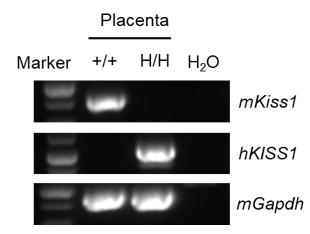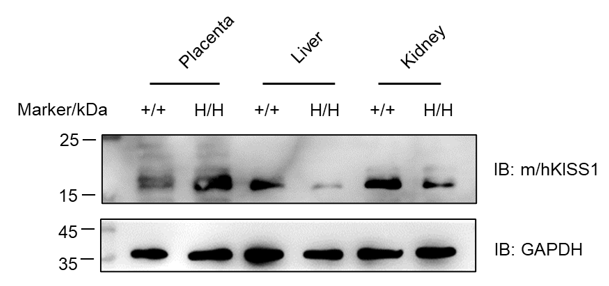B-hKISS1 mice
| Strain Name |
C57BL/6JNifdc-Kiss1tm1(KISS1)Bcgen/Bcgen
|
Common Name | B-hKISS1 mice |
| Background | C57BL/6JNifdc | Catalog number |
112958 |
|
Related Genes |
HH13, KiSS-1 |
||
|
NCBI Gene ID |
3814 | ||
- Kisspeptin, encoded by the Kiss1 gene, is a critical peptide hormone in the reproductive neuroendocrine axis. Hypothalamic Kiss1 neurons secrete kisspeptins, which act directly on gonadotropin-releasing hormone (GnRH) to stimulate GnRH release. GnRH then induces gonadotropin release from pituitary gonadotropes. The absence of proper kisspeptin signaling leads to absent or delayed puberty, hypogonadism, and infertility.
- Kiss1 neurons are mainly found in two distinct hypothalamic nuclei, the arcuate nucleus (ARH) and the anteroventral periventricular nucleus (AVPV/PeN). Kiss1ARH neurons mediate the pulsatile release of GnRH, while Kiss1AVPV/PeN are almost exclusive to the female brain and control the surge-like release of GnRH.
mRNA expression analysis

Strain specific analysis of KISS1 mRNA expression in wild-type C57BL/6JNifdc mice and homozygous B-hKISS1 mice by RT-PCR. Placenta RNA were isolated from wild-type C57BL/6JNifdc mice (+/+) and homozygous B-hKISS1 mice (H/H), then cDNA libraries were synthesized by reverse transcription, followed by PCR with mouse or human KISS1 primers. Mouse Kiss1 mRNA was detectable in placenta of wild-type C57BL/6JNifdc mice, human KISS1 mRNA was detectable only in placenta of homozygous B-hKISS1 mice but not in wild-type mice.

Western blot analysis of KISS1 protein expression in homozygous B-hKISS1 mice. Various tissue lysates were collected from wild-type C57BL/6JNifdc mice (+/+) and homozygous B-hKISS1 mice (H/H), and then analyzed by western blot with anti-KISS1 antibody(Abcam, ab275874). 40 μg total proteins were loaded for western blotting analysis. KISS1 was detected in pancreas, liver and kidney in wild-type mice and homozygous B-hKISS1 mice, as the antibody is cross-recognized between human and mouse KISS1. The Human KISS1 protein is highly expressed in placental tissues and low expressed in kidney and liver tissues.









